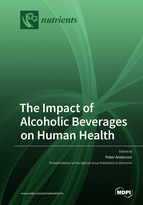The Impact of Alcoholic Beverages on Human Health
A special issue of Nutrients (ISSN 2072-6643). This special issue belongs to the section "Nutrition and Metabolism".
Deadline for manuscript submissions: closed (31 July 2021) | Viewed by 124173
Special Issue Editor
Interests: alcohol epidemiology; alcohol policy; primary health care and alcohol; alcohol industry
Special Issues, Collections and Topics in MDPI journals
Special Issue Information
Dear Colleagues,
Alcohol is often perceived as an underrated risk factor for human health. The aim of this Special Issue is to correct misperceptions and misinformation by providing up to date reviews and publications that consider the impact of alcoholic beverages on human health in the domains of toxicity, carcinogenicity, genotoxicity, foetal toxicity, neurotoxicity, impacts of alcohol on the gastrointestinal system (including nutrient deficiencies), cardiovascular system, injuries, body weight, and communicable diseases. Whilst it is the aim that the bulk of the papers cover issues of impact on health, reviews and papers should also address how the impact of alcohol on human health can be mitigated—for example, improved labelling on nutrients and health warnings, better policy measures, and actions by alcohol producers on their products through reformulation to lower alcoholic strength.
We aim for a state-of-the art Special Issue that describes in full the harm that alcohol can have on human health, and the measures that can be put in place to mitigate harm.
Prof. Dr. Peter Anderson
Guest Editor
Manuscript Submission Information
Manuscripts should be submitted online at www.mdpi.com by registering and logging in to this website. Once you are registered, click here to go to the submission form. Manuscripts can be submitted until the deadline. All submissions that pass pre-check are peer-reviewed. Accepted papers will be published continuously in the journal (as soon as accepted) and will be listed together on the special issue website. Research articles, review articles as well as short communications are invited. For planned papers, a title and short abstract (about 100 words) can be sent to the Editorial Office for announcement on this website.
Submitted manuscripts should not have been published previously, nor be under consideration for publication elsewhere (except conference proceedings papers). All manuscripts are thoroughly refereed through a single-blind peer-review process. A guide for authors and other relevant information for submission of manuscripts is available on the Instructions for Authors page. Nutrients is an international peer-reviewed open access semimonthly journal published by MDPI.
Please visit the Instructions for Authors page before submitting a manuscript. The Article Processing Charge (APC) for publication in this open access journal is 2900 CHF (Swiss Francs). Submitted papers should be well formatted and use good English. Authors may use MDPI's English editing service prior to publication or during author revisions.
Keywords
- Harm done by alcohol
- Alcohol toxicity
- Alcohol and cancer
- Alcohol and injuries
- Alcohol and communicable diseases
- Alcohol labelling
- Alcohol policy
- Reformulation alcoholic beverages







